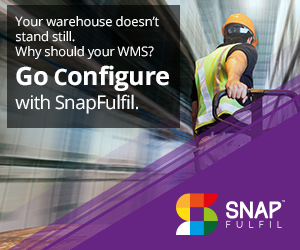Implementing a feature-rich WMS: Five steps to go-live
Today’s warehouse technology powers productivity on a scale unimaginable using paper-based systems. By consolidating your warehousing data into one location and allowing deeper visibility into your processes, a best-of-breed warehouse management system (WMS) gives you a foundation for better decision-making, streamlined processes and, ultimately, greater profit.
But before you invest in a WMS, it’s important to understand implementation is a collaborative process. Your WMS team will manage configuration, but you need to enter the process with set objectives for success, a plan for prepping your warehouse and employees, and an understanding that process improvement takes time.
Consider these five steps for feature-rich WMS implementation:
#1: Determine your pain points
A feature-rich WMS is like a swiss army knife – it provides a solution to many of your warehouse processes, from the minute you unload inventory to the minute items ship out. Still, it’s unwise to invest in and implement a WMS without understanding your primary pain points.
Start by taking a deep dive into each critical process. Spend a day with your team at each station: replenishment, picking, packing and shipping. You don’t need to scrutinize your team’s every move, but timing employees to see how long it takes to complete one cycle – an unload, a pick trip or packing a complete order. Not only will you gather high level data to set objectives for WMS process improvement (i.e. pick items 15 percent faster), but you’ll be better prepared to interview potential vendors and determine your optimal WMS.

#2: Calculate TCO
A best-of-breed WMS will drive efficiency and deliver value in the long run, but it does involve a significant upfront investment. That’s why it’s important to ask questions of the sales team: How long will implementation take, and will I lose productivity in the warehouse during go live? What’s my month-to-month cost? How many user licenses come with the core product, and how many will I need to purchase? Gather as much of this info from the sales team as possible, and ask if you can speak with any customers to validate the team’s estimates.
One way to save money before signing the contract: ask about flex licensing. Some best-of-breed WMS providers offer the opportunity to obtain extra licenses for short periods of time, giving you greater flexibility during your peak seasons.
#3: Give your warehouse a facelift
If your warehouse management relies on manual processes or older technology such as RF scanners, chances are your warehouse isn’t prepped for today’s technology. A best-of-breed WMS will deliver the data you need to reorganize your stock from an efficiency perspective, but you’ll need to move your stock to ensure the implementation team has access to your warehouse’s nooks and crannies. Create an area free from shelving so the team can install your wi-fi connection, and allow ample room for wire installation – specifically in areas where employees might accidently cut them.
One major space-related decision: is your WMS hosted on the cloud, or will the provider need to install servers on site? Most best-of-breed WMS platforms are now cloud-based, but if you’re responsible for housing the server, you’ll need to dedicate extra space and extra budget for upkeep. For on-site servers, you should also consider investing in a back-up in case your warehouse goes off-line.
#4: Train your team
For some warehouse managers, getting the team to buy in can be the most frustrating part of a WMS implementation. Perhaps employees are stuck in the “we’ve always done it this way” rut, or they’re not interested in mastering another piece of technology.
If you’d like to convert the skeptics, you’ll need an easy-to-use WMS that offers good onboarding and ongoing support. Because frontline employees will rely on your new system for everyday tasks, your provider should schedule at least 2-3 sessions during which the team can become comfortable navigating the WMS’ interface and see it in action. Employees should have a clear understanding of your new productivity objectives and how the WMS will assist in meeting them.
#5: Prepare for implementation
A WMS will impact your operations for the better, delivering the data your team needs to move faster, pack more efficiently and improve the customer experience. But this transformation doesn’t occur overnight. Implementation will take several weeks, and even once your system goes live, the WMS team will likely continue to fine tune the technology for a few weeks or even months.
That’s why it’s important to keep lines of communication open with your WMS team, even if you don’t see instant results. The team needs to keep a close eye on operations and note any bugs, or areas where processes don’t improve after a month or two. By maintaining collaboration between your warehouse and your tech providers, you’ll reach optimal operations quicker – and, ultimately, discover a faster return on investment.
A significant investment – and a significant improvement
Preparing your warehouse for a feature-rich WMS takes time, teamwork and trust – even more so if this is the first time you’ve implemented best-of-breed technology. Take it one step at a time, giving your current processes the attention they need so you can determine which solution is best for you. Once your WMS is implemented and you have deeper visibility into your process data, you’ll unlock a level of efficiency never possible with paper-based warehouse management. A feature-rich WMS is worth the investment.



